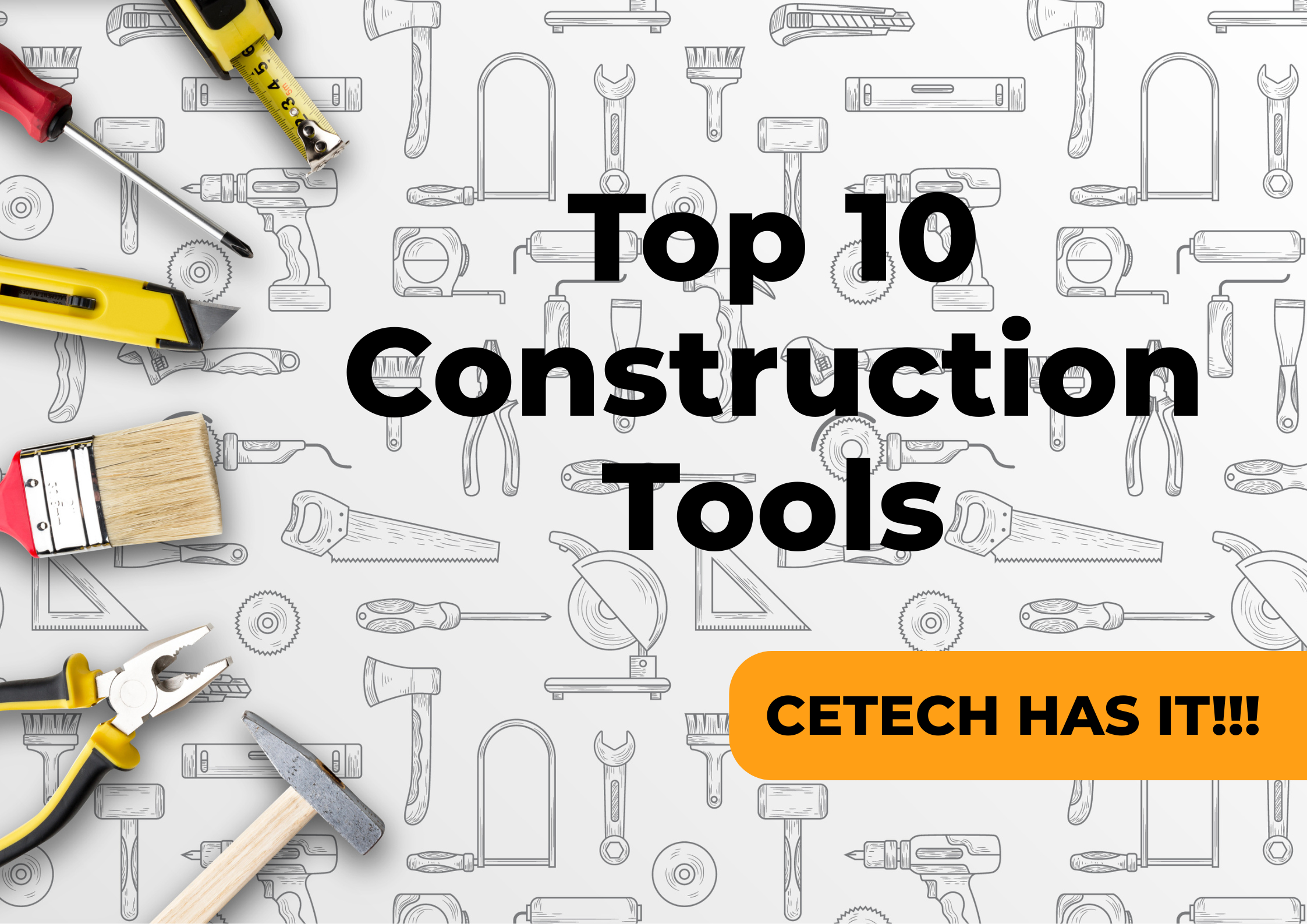Explore the top 10 construction tools and equipment with their uses. Learn about the best construction tools, building construction tools names, and how to use them effectively to boost your building projects.
In the world of construction, having the right tools is everything. Whether you’re a seasoned builder or just starting out, understanding construction tools and equipment with their uses can make your work more efficient and precise. From a simple basic construction tools list to the more specialized building construction tools, knowing what each tool does helps you tackle any project with confidence.
This guide will walk you through the best construction tools essential for any construction site. Ready to boost your toolbox? Let’s jump into the top 10 construction tools and equipment with their uses!
Here are the top 10 construction tools every builder needs:
- Measuring Tape
A flexible tape marked with measurements used for accurately measuring distances, lengths, and spaces on-site.
Uses:
- Measure wood, pipes, and other materials before cutting.
- Check dimensions for setting foundations or framing.
- Ensure accurate placement of fixtures and fittings.
- Hammer
A hand tool with a heavy metal head used for pounding nails or breaking apart objects.
Uses:
- Drive nails into wood or other materials.
- Remove nails with the claw end.
- Perform light demolition or dismantling tasks.
- Spirit Level
A tool with a liquid-filled vial that indicates if a surface is level (horizontal) or plumb (vertical).
Uses:
- Verify walls and floors are straight and even.
- Ensure doors and windows are installed correctly.
- Prevent uneven construction that could weaken the structure.
- Power Drill
An electrically powered tool that drills holes and drives screws quickly and accurately.
Uses:
- Drill holes in wood, metal, plastic, or masonry.
- Drive screws to assemble frames or attach fixtures.
- Speed up repetitive tasks with consistent precision.
- Screwdrivers
Manual tools with various tip types (Phillips, flathead) for turning screws.
Uses:
- Tighten or loosen screws in tight or delicate spaces.
- Provide more control than power drills for small tasks.
- Assemble furniture or install hardware.
- Utility Knife
A sharp, retractable knife with replaceable blades used for cutting.
Uses:
- Cut drywall, insulation, or plastic sheets cleanly.
- Score materials for easier breaking or shaping.
- Open packages and cut tapes safely on-site.
- Wheelbarrow
A small, single-wheeled cart used to carry and transport materials around the site.
Uses:
- Move heavy or bulky loads like cement, bricks, gravel.
- Transport tools and equipment quickly.
- Reduce physical strain and speed up material handling.
- Trowel
A small hand tool with a flat metal blade used for spreading and shaping mortar or plaster.
Uses:
- Spread mortar evenly between bricks or stones.
- Smooth surfaces for a professional finish.
- Repair cracks or apply plaster coatings.
- Plumb Bob
A weight attached to a string used to check vertical alignment.
Uses:
- Ensure walls, posts, or beams are perfectly vertical.
- Guide installations that require exact vertical placement.
- Double-check measurements for structural accuracy.
- Concrete Mixer
A machine that mixes cement, sand, water, and aggregates to produce concrete.
Uses:
- Blend materials evenly to ensure consistent concrete strength.
- Speed up mixing for large-scale foundation or floor pours.
- Reduce manual labor and improve concrete quality.
Safety Tips for Using Construction Tools and Equipment
Using the best construction tools is great, but safety always comes fOirst. Here are some must-know tips for staying safe on the job:
- Wear Personal Protective Equipment (PPE): Always use gloves, safety glasses, hard hats, and steel-toed boots to protect yourself from injuries.
- Inspect Tools Before Use: Check for any damage or wear on power cords, blades, or handles before starting.
- Follow Manufacturer Instructions: Read the user manuals for power tools and understand how to operate them properly.
- Use Tools for Their Intended Purpose: Don’t improvise or force tools to do tasks they aren’t designed for.
- Keep Your Work Area Clean: Clear away debris and clutter to avoid tripping or accidents.
- Store Tools Safely: Put tools away after use to prevent hazards and damage.
- Power Tools Safety: Unplug tools when not in use, avoid loose clothing, and use clamps or vices to secure workpieces.
Frequently Asked Questions About Construction Tools and Equipment with Their Uses
Q: What are construction tools?
A: Construction tools are any hand or power devices used to build, maintain, or repair structures.
Q: How to use power tools safely and effectively on a construction site?
A: Wear the right safety gear, inspect your tools before use, follow instructions, and never rush your work. Focus and care prevent accidents.
Q: What tools do construction workers use?
A: They use a wide range including measuring tapes, hammers, spirit levels, power drills, screwdrivers, utility knives, wheelbarrows, trowels, and concrete mixers.
Q: What tools are used in construction?
A: Construction tools include both hand and power tools designed for cutting, measuring, fastening, transporting, and finishing materials.
Q: What tools do construction workers need?
A: Essential tools like measuring tapes, hammers, spirit levels, power drills, and safety equipment form the foundation of any construction toolkit.
Q: What are the tools used in construction?
A: They are devices or equipment that assist in the building, repair, and finishing of structures.
Q: What tools do you need for construction?
A: A basic construction tools list includes measuring, cutting, fastening, transporting, and safety tools.
Ready to get your hands on the best construction tools and equipment? Visit CETECH Ghana Store, your trusted source offline or online at https://cetechbpa.com/gh for high-quality construction gear.
